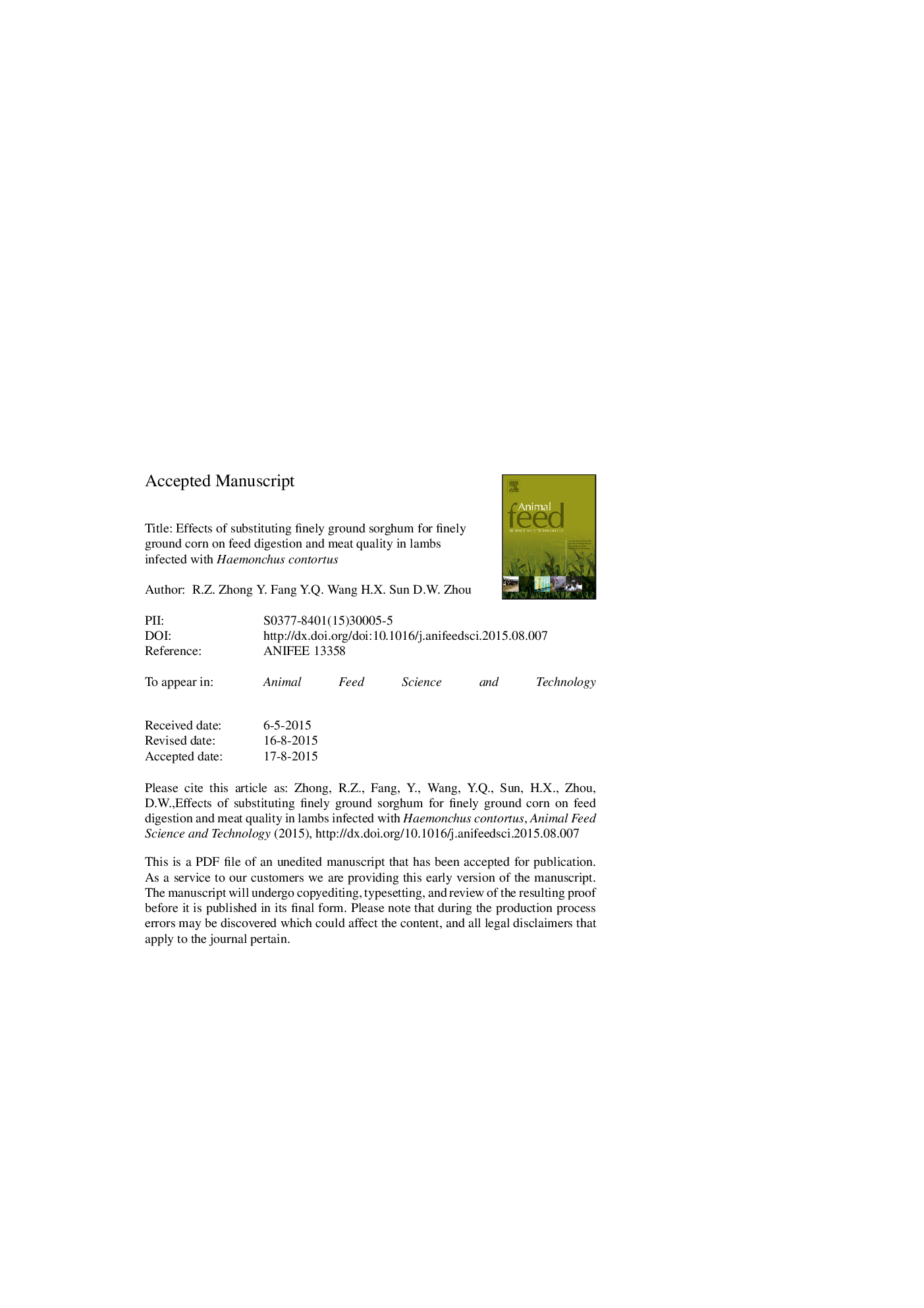| Article ID | Journal | Published Year | Pages | File Type |
|---|---|---|---|---|
| 8491296 | Animal Feed Science and Technology | 2016 | 32 Pages |
Abstract
The objective of this study was to determine the effects of substituting different levels of finely ground sorghum (FGS) for finely ground corn (FGC) on feed digestion and meat quality in lambs infected with Haemonchus contortus. Twenty-four male Ujumqin lambs at 90 ± 6.3 days of age were randomly assigned to receive one of four dietary treatments for 8 weeks prior to slaughter. The four diets contained 0 g/kg FGS and 400 g/kg FGC (CON), 100 g/kg FGS and 300 g/kg FGC (LFGS), 200 g/kg FGS and 200 g/kg FGC (MFGS), and 400 g/kg FGS and 0 g/kg FGC (HFGS). Before feeding, all lambs were dewormed and experimentally infected with 10,000 H. contortus third stage larvae. After a 28-day adaption to larvae infection, the feeding period was started. Fecal and blood samples were collected and lambs were weighed every 2 weeks. At the end of the feeding period, lambs were slaughtered, meat samples were collected, and the H. contortus burden in the abomasum was determined. The results demonstrated interaction effects between treatment and sampling time on fecal egg count (FEC; P < 0.001) and packed cell volume (PCV; P < 0.001) in lambs. The FEC decreased and the PCV increased significantly over the feeding period. As the dietary FGS content increased, the H. contortus burden in the abomasum, the abomasal mucosal surface (HBAM), and the abomasal contents (HBAC) decreased linearly (P < 0.001). In addition, the ratio of HBAM to HBAC decreased numerically but not linearly (P = 0.196) and the ratio of male to female H. contortus increased linearly (P = 0.016). Although dry matter intake decreased linearly (P = 0.001) as the dietary FGS content increased, no differences in the average daily weight gain and feed conversion ratio were observed between lambs in the FGS substitution groups and CON group. The apparent digestibility of all feed nutrients in the MFGS diet was numerically higher than those in other diets. As the dietary FGS content increased, the dressing percentage of lambs (P < 0.001), total heme pigment content (P < 0.001), and amount of tannins in meat increased linearly (P < 0.001). Diets containing 100-400 g/kg FGS did not affect total amino acids levels in meat, although levels of some individual essential amino acids increased as the FGS in diets increased. In conclusion, substitution of 100-400 g/kg FGS inclusion for equal amounts of FGC in diets is not only beneficial for protection of lambs against H. contortus infection but also for improving the meat color in lambs by increasing the deposition of antioxidant tannins in the meat.
Keywords
EAAfinely ground cornMDASorghum grainNDFFGSADGNEAAFGCFECADFFCRCAEHaemonchus contortusDMITBARSamino acidnon-essential amino acidacid detergent fiberepgconLambsCondensed tanninsCondensed tanninEggs per gramGINPacked cell volumeLightnessFecal egg countneutral detergent fiberRednessdry matteraverage daily gaindry matter intakecatechin equivalentYellownessfeed conversion ratioGastrointestinal nematodePCV یا Pneumococcal conjugate vaccinebody weightcrude proteinControlMeat quality
Related Topics
Life Sciences
Agricultural and Biological Sciences
Animal Science and Zoology
Authors
R.Z. Zhong, Y. Fang, Y.Q. Wang, H.X. Sun, D.W. Zhou,
